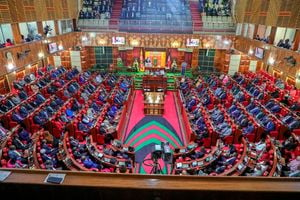Uhuru’s financial statement must seek to prepare Kenyans for austerity
In his budget last year, Mr Uhuru Kenyatta announced that the government would no longer buy vehicles.
Instead of tying the cash-flow in vehicles and other assets which depreciate in value, he said the government would lease the vehicles.
The option of leasing comes with a number of benefits. It allows you to introduce modern fleet management systems.
The leasing options also come with new technology for monitoring vehicle use and minimising waste of fuel.
Today, some of the biggest and most successful companies – Nakumatt, Tuskys, Kenya Airways, Westgate Shopping Mall, The east African Breweries, Unilever, James Finlay, CFC Stanbic, Commercial Bank of Africa, Standard Chartered, and Safaricom lease most of their equipment.
A year later, Uhuru’s proposal has wilted. Although the government put out a tender inviting leasing companies to submit expressions of interest, nothing has moved.
It would appear that individuals and institutions with vested interests in the current system have successfully campaigned to defeat the proposal.
Fleet replacement in government is big business. Over the years, it has spawned groups making money from supplying vehicles to the government.
There was a time when the car of choice for ministers was the Mercedes Benz. There was a time it was the Volvo. We still remember the hullabaloo which followed the shift from Mercedes to VW Passats.
Only occasionally bursting into the news, the struggle behind doors over fleet replacement within government is an intense political battle reflecting the political clout of networks with links with car-making companies.
Everybody in government appreciates that the economics of leasing make sense. But few insist on efficiency in the running of government fleets.
I only make reference to leasing as an entry point to a discussion on the subject of budget credibility.
Finance ministers in this country do not follow up to ensure that what they promised during the budget has been implemented.
Promises made can be discarded as soon as they are announced. Worse still, we don’t force ministers to demand that they report on the promises they made the previous year. It hurts the credibility of the budget.
Mr Kenyatta’s Sh1.2 trillion spending programme has been described as the biggest since independence. It has left pundits scratching their heads, trying to figure out where the money will come from.
After all, indications are that Kenya is facing economic hard times. Inflation is high, the balance of payments has weakened, and tax revenues have flattened .
In the circumstances, I expected this year’s budget to preach fiscal consolidation – not further expansion.
We needed to start moving away from the era of low interest rates and big budget deficits. Mr Kenyatta should start preparing the country for the inevitable consequences of austerity.
The realistic options open to Kenya is some form of fiscal squeeze combined with major changes in taxation, including eliminating unnecessary exemptions.
We have entered a period of belt-tightening. Today, Mr Kenyatta must spell out a comprehensive austerity programme.
This is not to say that we must suspend all pro-growth spending. We must keep development expenditures high and at the same time provide the money for the implementation of the Constitution.
I expect Mr Kenyatta’s statement today to provoke a debate about how to restructure the economy. We should start discussing job- and wealth-creation, and how to bring Kenya’s public debt under control.
The biggest challenge right now is how to restructure the economy so that it can deliver strong and consistent growth.
In its latest report, the Central Bank of Kenya’s Monetary Policy Committee has taken a very positive view of the economy.
It reports a ‘‘strong’’ performance of the agricultural sector, and also strong growth in the financial intermediation sector.
It says that the overall economic growth in the fourth quarter of 2010 at 6.9 per cent, revealed that the economy was on a high trajectory.
Take a step back from these statistics and employ a little more perspective and you will realise that although the statistics may be impressive, that growth is not dynamic.




